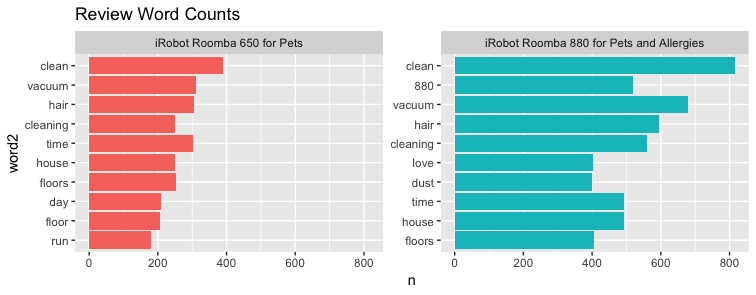Faceting word count plots
Introduction to Text Analysis in R

Maham Faisal Khan
Senior Data Science Content Developer
Counting by product
tidy_review %>%
count(word, product) %>%
arrange(desc(n))
# A tibble: 12,719 x 3
word product n
<chr> <chr> <int>
1 clean iRobot Roomba 880 for Pets and Allergies 815
2 vacuum iRobot Roomba 880 for Pets and Allergies 678
3 hair iRobot Roomba 880 for Pets and Allergies 595
# … with 12,716 more rows
Using slice_max()
tidy_review %>%
count(word, product) %>%
group_by(product) %>%
slice_max(n, n = 10)
# A tibble: 20 x 3
# Groups: product [2]
word product n
<chr> <chr> <int>
1 650 iRobot Roomba 650 for Pets 108
# … with 19 more rows
Using ungroup()
tidy_review %>%
count(word, product) %>%
group_by(product) %>%
slice_max(n, n = 10) %>%
ungroup()
# A tibble: 10 x 3
word product n
<chr> <chr> <int>
1 650 iRobot Roomba 650 for Pets 108
# … with 9 more rows
Using fct_reorder()
word_counts <- tidy_review %>%
count(word, product) %>%
group_by(product) %>%
slice_max(n, n = 10) %>%
ungroup() %>%
mutate(word2 = fct_reorder(word, n))
Using facet_wrap()
ggplot(word_counts, aes(x = word2, y = n, fill = product)) +
geom_col(show.legend = FALSE) +
facet_wrap(~ product, scales = "free_y") +
coord_flip() +
ggtitle("Review Word Counts")
Using facet_wrap()

Let's practice!
Introduction to Text Analysis in R

